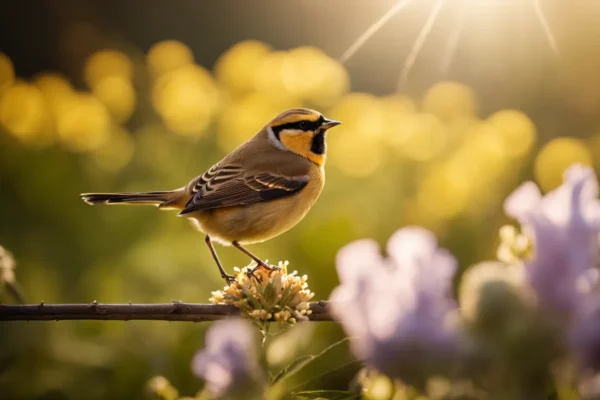You may have pondered, “What bird lays the smallest egg in the world?” if you have ever been astounded by the variety of birds and their amazing capacity to lay eggs. The response indicates a remarkable natural achievement.
For those with limited time, the following is a brief response to your inquiry: Less than half an inch is the tiniest egg that any bird has been known to deposit, and it is laid by the bee hummingbird.
We’ll go into further depth about the bee hummingbird and its small eggs in this post. We’ll examine the size of the bird and its eggs, the habitat of the species, and some important details about its incubation and hatching. We’ll also spotlight a few other species whose eggs are very tiny.
Prepare yourself for a close-up view of the tiny world of the bee hummingbird!
Facts about the Bee Hummingbird.
The world’s tiniest egg is laid by a remarkable kind of bird called the Bee Hummingbird. Scientists and bird lovers alike are fascinated by this little bird despite its diminutive size.
Let’s explore the realm of the Bee Hummingbird to learn more about this amazing animal.
The Tiniest Bird in the World
With a length of about 2.25 inches and a weight of only 0.06 ounces, the Bee Hummingbird is the tiniest bird on the planet and the smallest species of warm-blooded vertebrate. Considering that its eggs are much smaller, its tiny ness is rather astounding.
The size of the eggs laid by the Bee Hummingbird is comparable to that of a pea. The length and breadth of these small eggs are around 0.4 and 0.25 inches, respectively. The idea that a bird this little might lay an even smaller egg is astounding!
The Habitat of Bee Hummingbirds
Native to the island of Cuba, bee hummingbirds can be found in a range of environments, such as gardens, forests, and coastal regions. Notable for their exceptional dexterity, they frequently dart between flowers, consuming nectar and helping pollinate plants in the process.
If you’re fortunate enough to see one, the eastern and central parts of Cuba are probably where you’ll find it, as it likes to live among bushes and other dense vegetation. Because of their intense territoriality, these birds can be difficult to spot in the wild.
Behavior and Appearance
The Bee Hummingbird is a bright and colorful bird despite its diminutive size. The males’ throats shimmer a rich ruby-red, and their backs and heads display an amazing combination of iridescent green feathers.
In contrast, the females’ appearance is more subdued, featuring duller plumage and a white throat.
The amazing flying skills of Bee Hummingbirds are among their most amazing features. They have the ability to fly backward, hover in midair, and even fly upside down. They can stay suspended in the air to feed on nectar from flowers thanks to their amazing beat, which can reach up to 80 times per second.
Thus, pay attention to these little marvels the next time you’re in the great outdoors. Despite its diminutive size, the Bee Hummingbird makes a big impression!
Reproduction with Eggs
One of the most important aspects of a bird’s life cycle is the laying and incubation of eggs. The size and composition of their eggs are just two of the many strategies that birds have evolved to ensure the survival of their progeny.
Let’s investigate the intriguing world of avian eggs and the ways in which various bird species have responded to this problem in reproduction.
Little Eggs
Even though it’s common knowledge that birds lay eggs, not all eggs are made equally. Actually, the appropriately named bee hummingbird (Mellisuga helenae) is the owner of the smallest bird egg in the world. These little birds, which are found on the Isla de la Juventud and in Cuba, lay eggs that are only 0.5 centimeters long.
The bee hummingbird’s egg is roughly the size of a coffee bean, to put that into perspective!
But why are the eggs of bee hummingbirds so tiny? It all depends on the size and energy needs of the bird. At only 2.6 grams, bee hummingbirds are the smallest birds on the planet. Because of the limited amount of energy that their small size allows them to store, it is more efficient for them to lay smaller eggs.
Even though these eggs are small, they still have all the nutrients needed for the chick’s development.
Conversely, certain birds lay eggs that are significantly bigger than their bodies. For instance, at about 1.4 kg, the ostrich lays the biggest egg of any bird species. This variation in size demonstrates the extraordinary diversity of avian reproduction techniques.
Nesting and Taking Care of Parents
In order to safeguard and raise their eggs, birds have also evolved a variety of nesting habits and parental care techniques. Many species have a diverse range of nesting behaviors, from using tree cavities or digging burrows in the ground to constructing elaborate nests out of twigs and leaves.
Many bird species provide intensive parental care for the survival of their young after the eggs are laid. Some birds, for example, alternate between sitting on the nest and foraging for food while the other parent incubates the eggs.
This cooperative behavior guarantees that both parents have time to eat and rest, as well as helps to maintain the ideal temperature for the developing embryos.
Some bird species, like penguins, live in close-knit colonies where they share parental duties and construct nests. In certain instances, both parents take an active role in the process of incubating the eggs and providing care for the hatchlings.
It’s crucial to remember that different bird species devote different amounts of time and energy to raising their young. Some birds have developed a tactic called brood parasitism, such as the cuckoo. Cuckoos lay their eggs in other bird species’ nests rather than creating their own and tending to their own.
The cuckoo chicks are then raised by the gullible host birds as if they were their own, frequently at the expense of their own young.
The remarkable diversity and adaptability of these fascinating creatures is exemplified by birds’ ability to lay and tend to their eggs. Bird reproduction is a marvel worth studying, whether it’s the tiny eggs of the bee hummingbird or the intricate nesting habits of penguins.
Some Birds Laying Little Eggs
Hummingbird Vervain
Mellisuga minima, the scientific name for the vervain hummingbird, is a small species of bird that lives in Jamaica. It may not be the bird with the smallest egg in the kingdom, but it does lay eggs that are appropriately sized for its size.
The length of a vervain hummingbird egg is approximately 0.4 inches (1 centimeter), making it about the size of a pea. Because of their extreme fragility, the mother bird must take extra care of these eggs during incubation.
Cuban Emerald
Native to Cuba and the Bahamas, the Cuban emerald, or Chlorostilbon ricordii, is a species of hummingbird. This bird is another that, in relation to its size, lays relatively small eggs. The Cuban emerald hummingbird lays eggs that are about 0.6 inches (1.5 centimeters) longer than those of the vervain hummingbird.
These eggs, in spite of their diminutive size, are essential to the species’ survival and future growth.
Asian White-Eye
Zosterops palpebrosus, the scientific name for the Oriental white-eye, is a small passerine bird that can be found throughout Asia. It is worth mentioning here because of its small eggs, even though it may not be as well-known as some other bird species.
The Cuban emerald and Oriental white-eye share a similar size range of 0.6 inches (1.5 centimeters) for their eggs. These minuscule eggs are essential to the species’ ability to reproduce and to maintain its lineage.
Seeing how various bird species have evolved to lay eggs that correspond to their body size is fascinating. The vervain hummingbird lays the smallest egg in the world, but other birds also lay relatively small eggs, like the Oriental white-eye and Cuban emerald.
These eggs, despite their small size, are essential to the survival and procreation of these bird species.
Why Are The Eggs of these Birds so Little?
Ever ponder why certain birds deposit large eggs while others lay tiny ones? Numerous elements, such as the bird’s body size, habitat, and evolutionary adaptations, affect an egg’s size. Let’s investigate the causes of tiny eggs’ presence in the world of birds.
Restricted by Small Frame Size
Birds’ small bodies are one of the main causes of their small egg sizes. There is not as much room inside the bodies of smaller birds for them to lay and carry eggs. They have therefore evolved to lay eggs that are smaller and more in line with their body size.
This guarantees that they can effectively lay eggs and raise them without overtaxing their bodies.
For instance, the world’s tiniest bird, the bee hummingbird, lays eggs that are roughly the size of a pea. Compared to larger bird species, this tiny bird—which weighs only a few grams—is simply unable to lay and carry larger eggs.
Adjustment to Humid Environments
The adaptability of some bird species to tropical environments is another factor contributing to the prevalence of small eggs in these species. Because of intense competition for food and limited resources in tropical regions, birds have adapted to lay smaller eggs in order to survive.
Less energy is needed to create and maintain smaller eggs, which also require less nutrition for the developing embryo. This increases the likelihood that birds in tropical environments will survive in difficult habitats by enabling them to devote more resources to their own survival and foraging efforts.
For instance, compared to its larger counterparts in temperate regions, the eggs laid by the African sunbird, a small bird found in tropical regions of Africa, are noticeably smaller. The African sunbird is able to flourish in its difficult tropical environment because of this adaptation.
Gaining knowledge about the factors influencing bird egg size gives us amazing insights into the intricacy of natural adaptations. Birds have evolved to lay eggs that are ideal for their particular situation, regardless of whether their bodies are constrained by size or molded by environmental demands.
Final Thoughts
A true example of the extremes that evolution can produce is the bee hummingbird. It has had amazing success by laying the smallest of eggs, and it can even survive in small island environments. Scientists are still baffled by a number of factors, but it is evident that the bee hummingbird has adapted its reproduction to match its small size.
Consider the amazing variety of birds the next time you spot a hummingbird swarming around. Recall that the hummingbird bee, which produces the tiniest egg on Earth, is a living example of how great things can exist in tiny packages.





